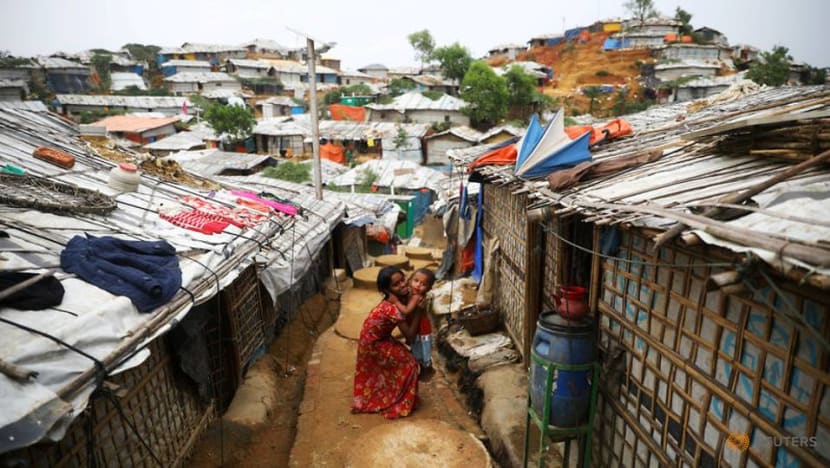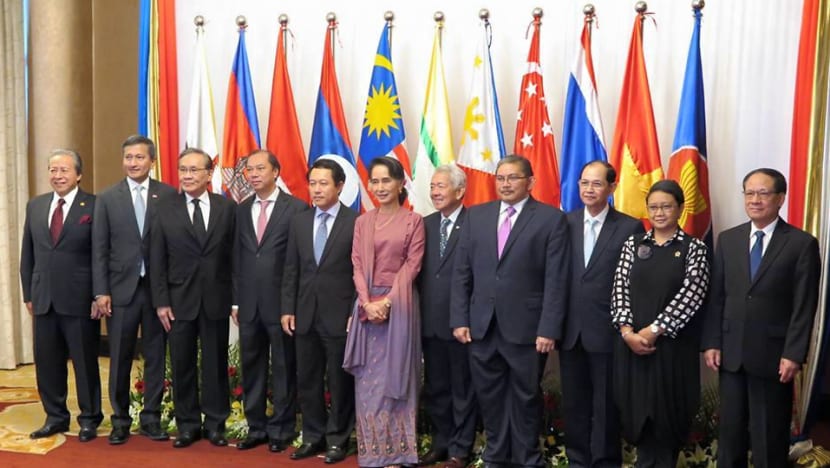commentary Commentary
Commentary: Myanmar on the cusp of opening up to mediation on Rakhine crisis
ASEAN can play a constructive role as the country awakens to the reality that doing nothing can no longer be an option, says ISEAS-Yusof Ishak Institute’s Moe Thuzar.

This picture taken on Jan 4, 2019 shows people displaced by violence between ethnic Rakhine rebels and Myanmar's army, arriving at a camp in Kyauktaw, Rakhine state. (Photo: AFP)
SINGAPORE: Discussion and debate continues, regionally and internationally, on how ASEAN can work with Myanmar in dealing with the humanitarian and political implications of the 2017 exodus of Rohingya communities from Myanmar’s Rakhine State to Bangladesh after a harsh military response to what Myanmar authorities have highlighted as terror attacks on the country’s sovereign soil.
Myanmar has recognised ASEAN’s role in assisting with the displaced communities’ humanitarian needs. It has also indicated willingness to address this via the good offices of the ASEAN Coordinating Centre for Humanitarian Assistance and Disaster Management (AHA Centre).
To this end, the ASEAN Emergency Response and Assistance Team (ASEAN-ERAT) has deployed several missions to Myanmar through 2018. The ASEAN Secretary-General also visited Myanmar in December 2018, to discuss how ASEAN could facilitate the stalled repatriation process.
The most recent deployment of the ASEAN-ERAT team to Myanmar in March had an added mission of assessing the situation on the ground for repatriation of the Rohingya refugees from Bangladesh.

READ: Why the Rohingya refugees should not be repatriated yet, a commentary
But the process has now been held hostage by the tense security situation in Rakhine, where the insurgent Arakan Army (AA) has launched raids and attacks on security posts since January.
The AA has framed the planned repatriation of the Rohingya as the Bamar-dominant central government’s “divide and rule” tactic against Rakhine people.
TIME FOR ASEAN TO STEP IN
Any opening for a greater ASEAN role in dealing with what is increasingly an embarrassment for the organisation, as well as for Myanmar vis-a-vis international interlocutors, presents an opportunity worth exploring.
ASEAN has employed creative interpretations of its non-interference principle in its quest to work constructively with Myanmar on its problems that have security implications for the rest of the region.
However, the longstanding nature of the Rohingya situation, which strikes at the heart of ethnicity and citizenship issues in Myanmar, has a domestic core to it. ASEAN’s role in Myanmar can only address aspects of the issue that affect regional interests.
READ: Twitter CEO Jack Dorsey’s tweet on Myanmar horrifies us because it’s the truth, a commentary
The role of humanitarian assistance as a soft(er) approach has thus become a precedent and a fall-back modus operandi familiar to both ASEAN and Myanmar since the Cyclone Nargis response in 2008.
Still, the AHA Centre’s mandate is primarily to deal with humanitarian situations arising from natural disasters. This has been stretched to accommodate Myanmar’s comfort-level over the Rohingya issue.
It may be time to find new pathways of working together, building on existing comfort-levels and approaches.
GROWING RECOGNITION IN MYANMAR THAT ‘DO NOTHING’ IS NOT AN OPTION
The growing recognition among Myanmar’s policy elite that “do-nothing” is not an option for the Rakhine/Rohingya issue also indicates a possible entry point.

According to the State of Southeast Asia: 2019 regional survey conducted by the ASEAN Studies Centre at the ISEAS – Yusof Ishak Institute, close to 60 per cent of Myanmar respondents indicated a preference for ASEAN to undertake a mediation role between the Myanmar government and other stakeholders.
Regionally, mediation is also the most preferred option for ASEAN to work with Myanmar on this issue (66.5 per cent). Humanitarian assistance is the second most preferred option regionally (50.9 per cent), followed by diplomatic pressure (38 per cent).
The findings indicate a possibility to explore how ASEAN can employ its mediation diplomacy to greater effect in Myanmar. ASEAN member states have offered such offices in the past, when the situation in one member state merits a collective effort for regional security.
READ: Did the Rohingya crisis snuff out foreign direct investments in Myanmar? A commentary
True to the ASEAN Way, this can only take place with the acquiescence of the concerned member state.
The mediating role taken on by former Indonesian foreign minister Dr Hassan Wirajuda in the peace talks between the Philippine government and the Moro National Liberation Front in the 1990s, as well as in the Aceh peace process, seem to provide an attractive option for Myanmar to consider, and for ASEAN to leverage.
The ASEAN Institute for Peace and Reconciliation (AIPR), which plays a think tank role on peace, conflict management and resolution, is working within ASEAN’s culture of consultative coordination, and can provide non-controversial cover in matching the peace-building needs of ASEAN members with existing mediation expertise in the region.
These discussions offer an additional venue for Myanmar, apart from the now de rigueur briefings at ministerial and summit-level meetings, to frankly discuss challenges in tackling the Rakhine/Rohingya situation amidst ongoing ceasefire negotiations and continuing clashes with ethnic armed organisations.
FIRST STEPS IN MEDIATION
ASEAN’s mediation role is, however, still nascent. It has undergone a long gestation period of confidence building under the ASEAN Regional Forum framework.

The AIPR’s activities in this area are a tentative first step towards greater confidence for ASEAN members to work together on sensitive issues. Still, a preference is emerging for ASEAN to serve as the mediating (and coordinating) platform, rather than third-party mediators.
Myanmar has had its fair share of the latter, with varying degrees of strategic interest in the country.
The presence of a neutral third party such as ASEAN – with over five decades of experience in honing capacities to reach compromises through dialogue – may help different stakeholders in Myanmar reach a workable compromise. Its role as a convenor also helped to broker the international response to the 2008 Cyclone Nargis in Myanmar.
With violent extremism, climate change, humanitarian emergencies and mass displacement now emerging as drivers of conflict, and posing a challenge to regional integration, the current political moment impels greater ASEAN-led efforts in preventive diplomacy, promotion of conflict resolution and peacebuilding, and recovery in member states still afflicted by conflict and tensions.
Moe Thuzar is Lead Researcher (socio-cultural) at the ASEAN Studies Centre of the ISEAS-Yusof Ishak Institute. These are her personal views.














